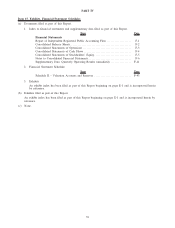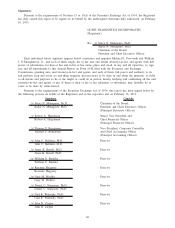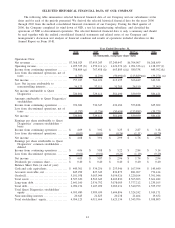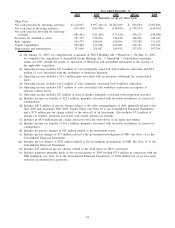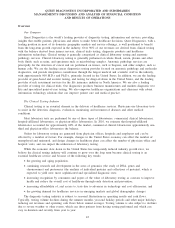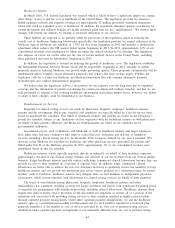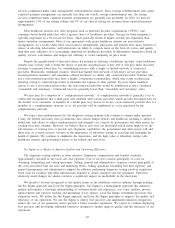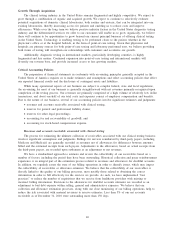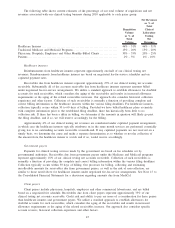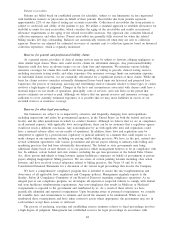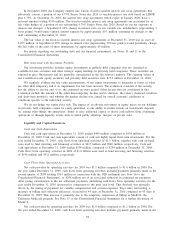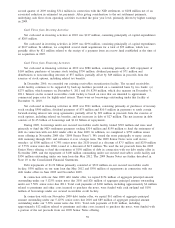Quest Diagnostics 2010 Annual Report Download - page 52
Download and view the complete annual report
Please find page 52 of the 2010 Quest Diagnostics annual report below. You can navigate through the pages in the report by either clicking on the pages listed below, or by using the keyword search tool below to find specific information within the annual report.generally accepted accounting principles. Changes in facts and circumstances related to such proceedings could
lead to significant revisions to reserve estimates for such matters and could have a material impact on our results
of operations, cash flows and financial condition in the period that reserve estimates are revised or paid.
Accounting for and recoverability of goodwill
We evaluate the recoverability and measure the potential impairment of our goodwill annually. The annual
impairment test is a two-step process that begins with the estimation of the fair value of the reporting unit. The
first step screens for potential impairment and the second step measures the amount of the impairment, if any.
Our estimate of fair value considers publicly available information regarding the market capitalization of our
Company, as well as (i) the financial projections and future prospects of our business, including its growth
opportunities and likely operational improvements, and (ii) comparable sales prices, if available. As part of the
first step to assess potential impairment, we compare our estimate of fair value for the reporting unit to the book
value of the reporting unit. We determine the fair value of the reporting units based on the income approach.
Under the income approach, we calculate the fair value of a reporting unit based on the present value of
estimated future cash flows. If the book value is greater than our estimate of fair value, we would then proceed
to the second step to measure the impairment, if any. The second step compares the implied fair value of
goodwill with its carrying value. The implied fair value is determined by allocating the fair value of the reporting
unit to all of the assets and liabilities of that unit as if the reporting unit had been acquired in a business
combination and the fair value of the reporting unit was the purchase price paid to acquire the reporting unit.
The excess of the fair value of the reporting unit over the amounts assigned to its assets and liabilities is the
implied fair value of goodwill. If the carrying amount of the reporting unit’s goodwill is greater than its implied
fair value, an impairment loss will be recognized in the amount of the excess. We believe our estimation
methods are reasonable and reflect common valuation practices.
On a quarterly basis, we perform a review of our business to determine if events or changes in
circumstances have occurred which could have a material adverse effect on the fair value of the Company and its
goodwill. If such events or changes in circumstances were deemed to have occurred, we would perform an
impairment test of goodwill as of the end of the quarter, consistent with the annual impairment test performed at
the end of our fiscal year on December 31st, and record any noted impairment loss.
Accounting for stock-based compensation expense
We record stock-based compensation as a charge to earnings, net of the estimated impact of forfeited
awards. As such, we recognize stock-based compensation cost only for those stock-based awards that are
estimated to ultimately vest over their requisite service period, based on the vesting provisions of the individual
grants. The process of estimating the fair value of stock-based compensation awards and recognizing stock-based
compensation cost over their requisite service periods involves significant assumptions and judgments.
We estimate the fair value of stock option awards on the date of grant using a lattice-based option-valuation
model which requires management to make certain assumptions regarding: (i) the expected volatility in the
market price of the Company’s common stock; (ii) dividend yield; (iii) risk-free interest rates; and (iv) the period
of time employees are expected to hold the award prior to exercise (referred to as the expected holding period).
The expected volatility under the lattice-based option-valuation model is based on the current and historical
implied volatilities from traded options of our common stock. The dividend yield is based on the approved
annual dividend rate in effect and current market price of the underlying common stock at the time of grant. The
risk-free interest rate is based on the U.S. Treasury yield curve in effect at the time of grant for bonds with
maturities ranging from one month to ten years. The expected holding period of the awards granted is estimated
using the historical exercise behavior of employees. In addition, we estimate the expected impact of forfeited
awards and recognize stock-based compensation cost only for those awards expected to vest. We use historical
experience to estimate projected forfeitures. If actual forfeiture rates are materially different from our estimates,
stock-based compensation expense could be significantly different from what we have recorded in the current
period. We periodically review actual forfeiture experience and revise our estimates, as considered necessary. The
cumulative effect on current and prior periods of a change in the estimated forfeiture rate is recognized as
compensation cost in earnings in the period of the revision.
The terms of our performance share unit grants allow the recipients of such awards to earn a variable
number of shares based on the achievement of the performance goals specified in the awards. For performance
share unit awards, the actual amount of any stock award earned is based on the compound annual growth rate of
the Company’s earnings per share from continuing operations over a three-year period as measured in accordance
with the provisions of the Amended and Restated Quest Diagnostics Incorporated Employee Long-Term Incentive
49


